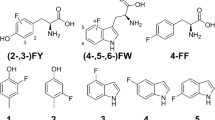Abstract
The elucidation of distinct protein conformers or states by fluorine (19F) NMR requires fluorinated moieties whose chemical shifts are most sensitive to subtle changes in the local dielectric and magnetic shielding environment. In this study we evaluate the effective chemical shift dispersion of a number of thiol-reactive trifluoromethyl probes [i.e. 2-bromo-N-(4-(trifluoromethyl)phenyl)acetamide (BTFMA), N-(4-bromo-3-(trifluoromethyl)phenyl)acetamide (3-BTFMA), 3-bromo-1,1,1-trifluoropropan-2-ol (BTFP), 1-bromo-3,3,4,4,4-pentafluorobutan-2-one (BPFB), 3-bromo-1,1,1-trifluoropropan-2-one (BTFA), and 2,2,2-trifluoroethyl-1-thiol (TFET)] under conditions of varying polarity. In considering the sensitivity of the 19F NMR chemical shift to the local environment, a series of methanol/water mixtures were prepared, ranging from relatively non-polar (MeOH:H2O = 4) to polar (MeOH:H2O = 0.25). 19F NMR spectra of the tripeptide, glutathione ((2S)-2-amino-4-{[(1R)-1-[(carboxymethyl)carbamoyl]-2-sulfanylethyl]carbamoyl}butanoic acid), conjugated to each of the above trifluoromethyl probes, revealed that the BTFMA tag exhibited a significantly greater range of chemical shift as a function of solvent polarity than did either BTFA or TFET. DFT calculations using the B3LYP hybrid functional and the 6-31G(d,p) basis set, confirmed the observed trend in chemical shift dispersion with solvent polarity.




Similar content being viewed by others
References
Bauschlicher CW, Partridge H (1995) The sensitivity of B3LYP atomization energies to the basis-set and a comparison of basis-set requirements for CCSD(T) and B3LYP. Chem Phys Lett 240:533–540
Dalvit C (2009) NMR methods in fragment screening: theory and a comparison with other biophysical techniques. Drug Discov Today 14:1051–1057
Dalvit C, Vulpetti A (2011) Fluorine-protein interactions and 19F NMR isotropic chemical shifts: an empirical correlation with implications for drug design. ChemMedChem 6:104–114
Didenko T, Liu JJ, Horst R, Stevens RC, Wüthrich K (2013) Fluorine-19 NMR of integral membrane proteins illustrated with studies of GPCRs. Curr Opin Struct Biol 23:740–747
Dolbier WR (2009) Guide to fluorine NMR for organic chemists. Wiley, Hoboken
Dong DC, Winnik MA (1982) The Py scale of solvent polarities. Solvent effects on the vibronic fine structure of pyrene fluorescence and empirical correlations with ET and Y values. Photochem Photobiol 35:17–21
Dong DC, Winnik MA (1984) The Py scale of solvent polarities. Can J Chem Rev Can De Chim 62:2560–2565
Gakh YG, Gakh AA, Gronenborn AM (2000) Fluorine as an NMR probe for structural studies of chemical and biological systems. Magn Reson Chem 38:551–558
Gerig JT (1994) Fluorine NMR of proteins. Prog Nucl Magn Reson Spectrosc 26:293–370
Gerig JT, Klinkenborg JC, Nieman RA (1983) Assignment of fluorine nuclear magnetic-resonance signals from rabbit cyanomethemoglobin. Biochemistry 22:2076–2087
Hehre WJ (2003) A guide to molecular mechanics and quantum chemical calculations. Wavefunction Inc, Irvine
Jackson JC, Hammill JT, Mehl RA (2007) Site-specific incorporation of a 19F-amino acid into proteins as an NMR probe for characterizing protein structure and reactivity. J Am Chem Soc 129:1160–1166
Janjic JM, Ahrens ET (2009) Fluorine-containing nanoemulsions for MRI cell tracking. Wiley Interdiscip Rev Nanomed Nanobiotechnol 1:492–501
Kalbitzer HR, Rohr G, Nowak E, Goody RS, Kuhn W, Zimmermann H (1992) A new high-sensitivity 19F probe for labeling cysteine groups of proteins. NMR Biomed 5:347–350
Kim TH, Chung KY, Manglik A, Hansen AL, Dror RO, Mildorf TJ, Shaw DE, Kobilka BK, Prosser RS (2013) The role of ligands on the equilibria between functional states of a G protein-coupled receptor. J Am Chem Soc 135:9465–9474
Kitevski-LeBlanc JL, Prosser RS (2012) Current applications of 19F NMR to studies of protein structure and dynamics. Prog Nucl Magn Reson Spectrosc 62:1–33
Klein-Seetharaman J, Getmanova EV, Loewen MC, Reeves PJ, Khorana HG (1999) NMR spectroscopy in studies of light-induced structural changes in mammalian rhodopsin: applicability of solution 19F NMR. Proc Natl Acad Sci USA 96:13744–13749
Lau E, Gerig J (2000) Origins of fluorine NMR chemical shifts in fluorine-containing proteins. J Am Chem Soc 122:4408–4417
Li C, Wang G, Wang Y, Creager-Allen R, Lutz EA, Scronce H, Slade KM, Ruf RAS, Mehl RA, Pielak GJ (2010) Protein 19F NMR in Escherichia coli. J Am Chem Soc 132:321–327
Lian CY, Lian CY, Le HB, Montez B, Patterson J, Harrell S, Laws D, Matsumura I, Pearson J, Oldfield E (1994) 19F nuclear-magnetic-resonance spectroscopic study of fluorophenylalanine-labeled and fluorotryptophan-labeled avian egg-white lysozymes. Biochemistry 33:5238–5245
Liu JJ, Horst R, Katritch V, Stevens RC, Wüthrich K (2012) Biased signaling pathways in β2-adrenergic receptor characterized by 19F-NMR. Science 335:1106–1110
Luchette P, Prosser R, Sanders C (2002) Oxygen as a paramagnetic probe of membrane protein structure by cysteine mutagenesis and 19F NMR spectroscopy. J Am Chem Soc 124:1778–1781
Manglik A, Kim TH, Masureel M, Altenbach C, Yang Z, Hilger D, Lerch MT, Kobilka TS, Thian FS, Hubbell WL, Prosser RS, Kobilka BK (2015) Structural insights into the dynamic process of β2-adrenergic receptor signaling. Cell (in press)
Pearson JG, Oldfield E, Lee FS, Warshel A (1993) Chemical shifts in proteins—a shielding trajectory analysis of the fluorine Nuclear-Magnetic Resonance spectrum of the Escherichia coli galactose binding protein using a multipole shielding polarizability local reaction field molecular-dynamics approach. J Am Chem Soc 115:6851–6862
Shao Y et al (2006) Advances in methods and algorithms in a modern quantum chemistry program package. Phys Chem Chem Phys 8:3172–3191
Sloop JC (2013) 19-Fluorine nuclear magnetic resonance chemical shift variability in trifluoroacetyl species. Rep Org Chem 3:1–12
Street KW, Acree WE (1986) The Py solvent polarity scale—binary solvent mixtures used in reversed-phase liquid-chromatography. J Liq Chromatogr 9:2799–2808
Yu JX, Hallac RR, Chiguru S, Mason RP (2013) New frontiers and developing applications in 19F NMR. Prog Nucl Magn Reson Spectrosc 70:25–49
Acknowledgments
We would like to thank the Natural Sciences and Engineering Research Council of Canada for support of this research. Supported by NSERC research discovery award (Grant No. 261980).
Author information
Authors and Affiliations
Corresponding author
Additional information
Libin Ye and Sacha Thierry Larda have contributed equally to this work.
Electronic supplementary material
Below is the link to the electronic supplementary material.
Rights and permissions
About this article
Cite this article
Ye, L., Larda, S.T., Frank Li, Y.F. et al. A comparison of chemical shift sensitivity of trifluoromethyl tags: optimizing resolution in 19F NMR studies of proteins. J Biomol NMR 62, 97–103 (2015). https://doi.org/10.1007/s10858-015-9922-y
Received:
Accepted:
Published:
Issue Date:
DOI: https://doi.org/10.1007/s10858-015-9922-y




